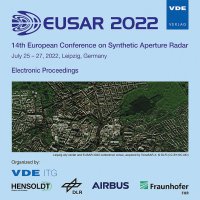Estimation of Volume Decorrelation from TanDEM-X Bistatic Coherence
Konferenz: EUSAR 2022 - 14th European Conference on Synthetic Aperture Radar
25.07.2022 - 27.07.2022 in Leipzig, Germany
Tagungsband: EUSAR 2022
Seiten: 6Sprache: EnglischTyp: PDF
Autoren:
Rizzoli, Paola; Dell’Amore, Luca; Bueso-Bello, Jose-Luis; Gollin, Nicola; Martone, Michele (Microwaves and Radar Institute, German Aerospace Center (DLR), Wessling, Germany)
Inhalt:
The bistatic interferometric coherence is affected by different sources of error, among which volume decorrelation, which quantifies the amount of noise caused by volume scattering mechanisms. This represents a key quantity not only for performance assessment purposes, but also for a large variety of scientific applications, ranging from land cover classification to biomass retrieval, and it can be isolated by properly compensating for all other decorrelation sources. Considering that temporal decorrelation can be reasonably neglected for a bistatic system, the remaining components can be estimated from the SAR scene and system parameters. In the scientific community, it is common practice to approximate the volume decorrelation with the total coherence or to compute it by compensating for the signal-to-noise ratio (SNR) decorrelation only, which typically represents the dominant decorrelation component. Nevertheless, a precise knowledge of the system allows for a better retrieval of such a quantity and impacts its application. The aim of this paper is to provide the readers with a practical procedure for precisely computing the volume decorrelation from TanDEM-X bistatic data. In particular, we concentrate on the two components which have the most relevant impact: the SNR and the quantization components. Regarding the first one, we estimated the noise equivalent σ nought directly from real SAR data and we provide the users with a set of polynomial coefficients for the retrieval of the system noise floor for each operational TanDEM-X StripMap beam. Concerning the decorrelation due to quantization, we provide the user with a set of empirical look-up-tables (LUT) for quantifying its impact on the coherence depending on backscatter local statistics and quantization rate. Finally, we provide reasonable assumptions for all other remaining decorrelation sources.


